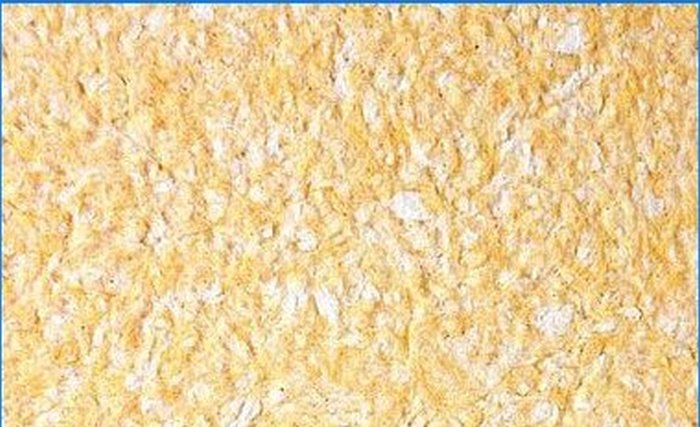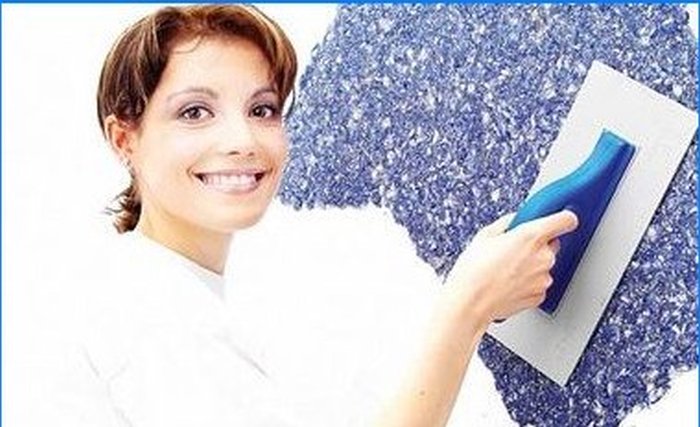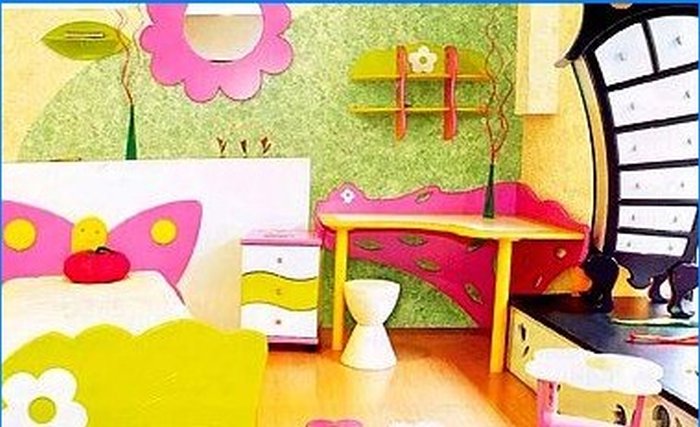Recommendation points
- Composition of liquid wallpaper
- Characteristics of liquid wallpaper
- Preparing liquid wallpaper for use
- Surface preparation
- Methods for preparing the main types of surfaces
- Concrete-lime surface
- Plasterboard surface
- Wood surface
- Painted surfaces
- Applying liquid wallpaper
- Using liquid wallpaper in non-standard situations
- Yellow spots
- Mechanical damage
- Red spots
- Curved surfaces
- Creativity
- Painting
- Deleting
The article tells about a new finishing material – Bioplast liquid wallpaper. The following issues are considered: composition of liquid wallpaper; characteristics of liquid wallpaper; preparation of liquid wallpaper for use; surface preparation; methods of preparing the main types of surfaces; applying liquid wallpaper; use of liquid wallpaper in non-standard situations.
Bioplast finishing material is a kind of decorative plaster. Textile fibers, cellulose, an adhesive component and various decorative elements are used to create the base of this liquid wallpaper. Liquid wallpaper is intended for interior decoration of residential and office premises. This material has good adhesion and elasticity. It can be used to decorate walls, ceilings and curved surfaces.
Composition of liquid wallpaper
Decorative liquid wallpaper consists of several environmentally friendly components that meet the most stringent sanitary standards: cellulose, textile fibers and carboxymethyl cellulose or CMC.
Cellulose is a raw material obtained from wood processing and is used in many manufacturing industries. In particular, cellulose is used to make paper and standard roll wallpaper..
For the production of Bioplast material, safe textile fibers of artificial silk with high consumer qualities are used..
CMC binder, also obtained in the process of wood processing and used in the food and cosmetic industry, is used in the production of liquid wallpaper as an adhesive.
Characteristics of liquid wallpaper
Bioplast liquid wall-paper is distinguished by odorlessness, high heat and sound insulation properties, vapor permeability, elasticity, frost resistance, as well as the absence of seams during application. These qualities are achieved through the use of natural fibers – the best building material created by nature itself. Due to the above properties, Bioplast liquid wallpaper is perfect for finishing unheated rooms and surfaces with a high content of microcracks, for example, walls in new buildings. This material can also be applied over old plaster. In addition, liquid wallpaper has antistatic properties, that is, it does not attract dust. Therefore, they can be easily cleaned with a dry brush or vacuum cleaner..

As practice shows, in any room there are places with increased operational load. In apartments, these are surfaces around electrical switches, in offices, corridors and walls located behind the backs of chairs. All these places get dirty pretty quickly. But if the walls are covered with liquid wallpaper, then you won’t have to completely repair the room. It is enough to treat the damaged area with a plastic float, and then apply a new layer of Bioplast. The difference in shades between the old liquid wallpaper and the renewed area will be practically invisible, since this material does not change its original color over time and under the influence of sunlight.
Preparing liquid wallpaper for use
Pour 40-50 ° C water into a clean plastic container in the amount indicated on the package. Pour the contents of the bag into the water. Stir with your hands until clots and dry spots disappear, cover with a lid or plastic bag and leave for 8 hours. After this time, the mixture is ready for use. In a soaked form, the composition without loss of properties can remain for no more than 5 days at a temperature of 20 ° C.
Surface preparation
The surface on which it is planned to apply Bioplast liquid wallpaper must not absorb moisture, otherwise stains may appear on it..
The surface color must be either white or the same shade as the liquid wallpaper.
The surface must first be cleaned of old wallpaper, whitewash, nails and other metal objects.

In principle, Bioplast will also stick to old wallpaper, but they will absorb moisture and will soon move away from the surface by themselves..
It is customary to remove whitewash in any case, since it is not a bonding material.
Upon contact with moisture contained in liquid wallpaper, metal objects left on the surface will begin to rust, as a result of which ugly red spots will appear.
Methods for preparing the main types of surfaces
Concrete-lime surface
Treat the concrete-lime surface with one coat of starter filler. Permissible irregularities will not affect the mechanism for applying liquid wallpaper. To protect the surface from moisture penetration, lay a deep penetrating white primer or primer paint on it. Bioplast liquid wallpaper can be applied after the surface is completely dry.
Plasterboard surface
Apply two coats of putty to drywall, then prime with white acrylic primer or primer paint.
Wood surface
First coat plywood or chipboard with alkyd enamel and then apply one coat of primer.
Painted surfaces
Carefully inspect panels painted with enamels or oil paints for delamination and blistering. Remove these areas and, if necessary, treat the surface with a putty. Then apply two coats of primer paint.
Applying liquid wallpaper
Stir the prepared mass again just before use. Start applying wallpaper from one corner to the other from the same batch to avoid splitting. If the edge still has time to dry, moisten it with water, let it absorb moisture, then smooth it with a plastic float.

Apply liquid wallpaper in a layer 1 to 2 mm thick. In this case, it is not necessary to form the surface – the material itself will take the desired shape. If you could not stand the thickness of the layer, do not be discouraged. If it is thinner, the surface will dry faster, and if it is thicker, the wallpaper will take longer to dry. The material consumption will also change. But in any case, it is desirable that the layer thickness is the same over the entire surface..
Apply the Bioplast mixture not in a circular motion, but in a back and forth motion. At the same time, smooth the surface no more than 10 passes, so as not to rub the silk fiber and change the appearance of the wallpaper..
To make the material dry faster, you need to ventilate the room well. Use heaters in cool and humid weather.
Using liquid wallpaper in non-standard situations
Yellow spots
In old houses, yellow spots sometimes appear on the walls, even through several layers of putty. This can be caused by the use of chemically active compounds, for example, copper sulfate, which was previously one of the most common materials. To hide yellow stains under a layer of liquid wallpaper, spray the damaged areas with a regular cotton bleach, such as Whiteness. After 20 minutes, there will be no stains left! Ventilate the room until the chlorine odor disappears completely, and then proceed with the application of liquid wallpaper.
Mechanical damage
If you find heavy dirt, abrasions and other mechanical damage, soak the place to be repaired, as well as a 10-cm area around it, let the material absorb moisture, and then smooth the surface with a plastic float.
Red spots
Rust spots can appear on the wallpaper if all small metal objects have not been removed from the surface before applying them: nails, screws, etc. To remedy the situation, first remove the damaged piece of wallpaper, and then paint over the place with alkyd enamel. After it dries, apply liquid wallpaper to the area to be repaired and smooth the surface with a plastic float.
Curved surfaces
Bioplast liquid wall-paper can be applied to surfaces with a high degree of curvature: beads, cylindrical columns or pipes. Use a set of rubber spatulas for this purpose, which are used to grind tile joints. Please note that material consumption in this case will be higher than indicated on the packaging.
Creativity
With the help of Bioplast liquid wallpaper, you can create an individual unusual design of a room by combining various textures, mixing original shades or applying an original pattern to the wall..

Transfer the design to the surface, apply liquid wallpaper of the desired color to it and leave to dry completely. After that, trim the edge along the outline of the image and cover it with masking tape. Apply liquid wallpaper of a different tone back to back and dry as well. Then cut the contour of the joint of the color shades and remove the masking tape.
Painting
If after a while you want to change the color of the walls or ceiling, apply two coats of water-based paint over Bioplast liquid wallpaper. However, keep in mind that it will no longer be possible to soak the material..
Deleting
To remove liquid wallpaper from the surface, just wet it. After the material takes on a plastic consistency, remove it from the surface using an ordinary spatula. Please note that some types of liquid wallpaper can be reused.

Can you provide more information about Bioplast liquid wallpaper? How does it differ from traditional wallpaper? What are the advantages of using Bioplast? Is it easy to apply and remove? Are there any specific maintenance requirements or care instructions?
Bioplast liquid wallpaper is a modern alternative to traditional wallpaper. It is made from natural materials such as cellulose, cotton, and silk fibers mixed with natural binders and pigments. Unlike traditional wallpaper, it is applied as a liquid mixture, which then dries to create a seamless and textured surface on walls.
The main advantage of using Bioplast is its eco-friendliness and sustainability. It is free from harmful chemicals and toxins, making it safe for both humans and the environment. Additionally, it is breathable, resistant to moisture, and has insulating properties.
Applying Bioplast liquid wallpaper is relatively easy, and it can be done by anyone with basic DIY skills. It comes in a pre-mixed form, eliminating the need for complicated preparations. Removal is also simple, with the wallpaper peeling off easily without leaving any residue.
In terms of maintenance, Bioplast is low maintenance. It can be wiped clean with a damp cloth or dry brushed to remove dust. However, it is important to avoid using harsh chemicals or abrasive materials that can damage the textured surface. Overall, Bioplast liquid wallpaper offers a more sustainable and user-friendly alternative to traditional wallpaper.
Bioplast liquid wallpaper is a modern and eco-friendly alternative to traditional wallpaper. Made from natural materials, it is safe for both humans and the environment. Its seamless and textured surface is created by applying a liquid mixture that dries on walls. With its moisture resistance and insulating properties, it is easy to apply and remove, making it convenient for DIY projects. Maintenance is also simple, with easy cleaning and no need for harsh chemicals. Bioplast liquid wallpaper is a sustainable and user-friendly choice for those looking for a greener option for their walls.
Bioplast liquid wallpaper is an eco-friendly and sustainable alternative to traditional wallpaper, made from natural materials and free from harmful chemicals. It is easy to apply and remove, requiring minimal maintenance. Its textured surface is breathable, moisture-resistant, and insulating. Overall, Bioplast offers a user-friendly and environmentally conscious option for decorating walls.
Bioplast liquid wallpaper is a modern alternative to traditional wallpaper. Unlike regular wallpaper, it is made from a mixture of natural materials like textile fibers, clay, and water-based binders. This eco-friendly composition makes it biodegradable and non-toxic.
Bioplast stands out due to its versatility and ease of application. It can be directly applied to walls, ceiling, or other surfaces without the need for any additional prepping or adhesive. This saves time and effort during installation. Additionally, it can be easily removed by dampening the surface and peeling it off, leaving no residue behind.
The advantages of using Bioplast liquid wallpaper are numerous. It provides excellent coverability, hiding imperfections on walls effectively. Its natural fibers make it breathable, preventing mold and mildew growth. Bioplast is also heat and sound-insulating, adding to the overall comfort of a space. It is durable and long-lasting, retaining its appearance for years.
Maintenance requirements for Bioplast are minimal. Regular dusting or wiping with a damp cloth should suffice to keep it clean. In case of stains, gentle spot cleaning is recommended. Overall, Bioplast liquid wallpaper offers an easy and sustainable way to enhance the look of any interior space.
I’m curious about liquid wallpaper Bioplast. Can you provide more information on its application process and durability?
What are the main advantages and disadvantages of using bioplast liquid wallpaper compared to traditional wallpapers?
Bioplast liquid wallpaper offers several advantages over traditional wallpapers. It is eco-friendly and made from natural materials, making it a sustainable choice. It has a longer lifespan and is more durable, with higher resistance to wear and tear. Bioplast liquid wallpaper is also easy to apply and remove, saving time and effort. Moreover, it can conceal surface imperfections and cracks, providing a smooth and flawless finish. However, it also has some drawbacks. It is more expensive than traditional wallpapers and may have limited design options. It requires professional installation, which adds to the overall cost. Additionally, its application process can be messy and time-consuming. Despite these disadvantages, the sustainable nature and durability of bioplast liquid wallpaper make it a preferred choice for many.
Bioplast liquid wallpaper is an eco-friendly and sustainable option made from natural materials. It has a longer lifespan, is more durable, and offers higher resistance to wear and tear compared to traditional wallpapers. Its easy application and removal save time and effort, while also concealing imperfections for a flawless finish. However, it is more expensive and may have limited design options. Professional installation and a messy application process add to the overall cost and time. Despite these drawbacks, its sustainability and durability make it a preferred choice for many.
Bioplast liquid wallpaper is a sustainable and eco-friendly option that offers durability and resistance to wear and tear. It is easy to apply and remove, conceals imperfections, and provides a smooth finish. However, it is more expensive, has limited design options, and requires professional installation. Despite these drawbacks, its longevity and eco-friendly features make it a popular choice for those looking for a sustainable and durable wallpaper option.
One of the main advantages of using bioplast liquid wallpaper is its eco-friendliness. Made from natural ingredients like cellulose and cotton fibers, it is biodegradable and non-toxic, making it a sustainable choice for environmentally conscious consumers. Bioplast liquid wallpaper is also easy to apply, as it can be rolled or sprayed onto walls, creating a seamless and smooth finish.
However, there are also some disadvantages to consider. Bioplast liquid wallpaper can be more expensive than traditional wallpapers, due to its natural ingredients and production process. It is also less durable than traditional wallpapers, as it may tear or scratch more easily. Additionally, bioplast liquid wallpaper may require more maintenance and care, as it can be more challenging to clean or repair compared to traditional wallpapers.
Can you please explain what exactly is liquid wallpaper bioplast and how does it differ from traditional wallpaper?